
 |

 ugh Marlowe
(Jan
30.1911 - May 2.1982) ugh Marlowe
(Jan
30.1911 - May 2.1982) |
|
|
Height: between
5'11" and 6'1". Weight: 170-175 pounds Eyes: blue Hair: brown Marriages: (1) Margaret (Peggy) Davis, radio drama actress (Nov 23. 1932 - Feb 17. 1938, divorced) (2) Edith Atwater, actress (Nov 15/18, 1941 - Sep 16. 1945, divorced) (3) K.T. Stevens (aka Gloria Wood), actress (May 7. 1946 - Sep 1967, divorced) Sons: Chris(tian) Marlowe, sportscaster (Sep 28. 1951) Jeff Marlowe, cinematographer (Jul 7. 1948) (4) Rosemary Macellaro Torri, actress (aka Rosemary Murtagh) (1968 - 1982, his death) Son : Hugh Marlowe Jr. (Feb 1969) Siblings: Sidney & G. Worthington (twins, 1909), Shirley R. (1912) |
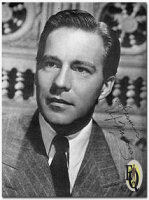 |
|
Hugh Marlowe was born on January 30. 1911
as Hugh Herbert Hipple in Philadelphia, Pennsylvania, son of George W. Hipple
and Mildred Schroeder of
Chicago. He was in little-theatre work (The Goodman Little Theater group), toiled as truck driver, grocery clerk, tie salesman in between his earliest acting jobs. A newspaper report dated May 3. 1931, reported that Little Theatre groups would be represented in the annual drama competition. The Players Guild of Evanston brought The String of the Samisen by Rita Wellman; with among others Brett Morrison (The Shadow!), Hugh Hipple and Miss Peggy Davis. They came in second but won the award for best diction. On November 29. 1931 the same guild staged The Mollusc in its studio theatre under direction of Melita H. Skillen, director of dramatic art at Senn High School. The group was largely made up of Senn High graduates who pleaded to further develop the talent she discovered. Hugh Hipple is mentioned as a member of the players' staff having played in the comedy You and I earlier that month. Started his career as a radio announcer at WOC-WHO in Davenport/Des Moines, Iowa in 1931 - 1932. The actor was remembered by staff as "a thick-spectacled, mustached, long-haired lover of horseplay, whose resonant voice and flawless diction seemed at first, an affectation." |
|
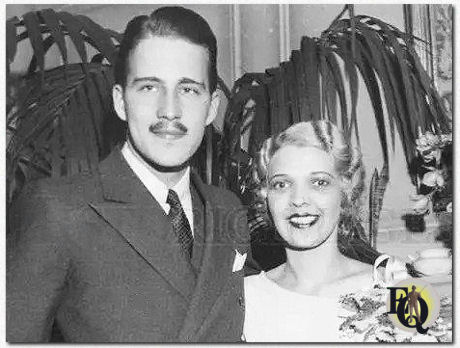 Above: Miss Margaret Davis, daughter of a Chicago department store owner, and Hugh Hipple, announced on a Davenport, Iowa, radio station, are seen here after their wedding in the bride's home at Evanston, Illinois. |
|
|
In November 1932 he married Peggy Davis from Chicago. She was the daughter of Arthur Davis, a former executive of State Street department store. They met when Miss Davis took part in an amateur theatrical organization to which Hipple belonged, and their friendship was strengthened through mutual interests when both entered the radio field. Miss Davis appeared in radio presentations (Princess Pat, NBC). When he left the WOC-WHO station his old job was given to another would-be actor named Ronald Reagan. In March 1933 it was announced that Hugh Hipple was added to the announcing staff of KYW, Chicago. After being a radio announcer for two years, he quit to attend Pasadena Playhouse in California for training (still as Hugh Hipple). |
|
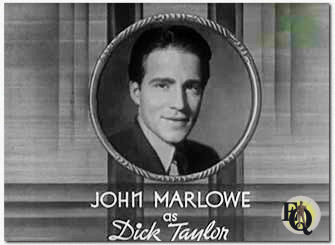 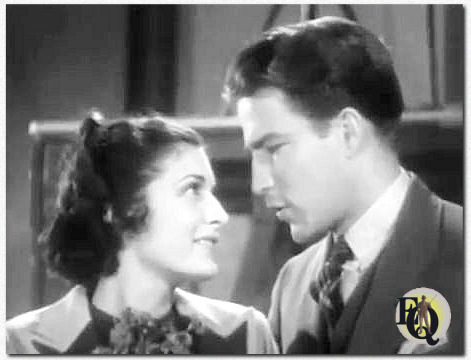 Above left: Marlowe's film debut as John Marlowe in Brilliant Marriage (Chesterfield, Mar 25. 1936). Above right: It Couldn’t Have Happened (But It Did) (Chesterfield, Aug 1. 1936) Evelyn Brent as Beverly makes goo-goo eyes at Edward (Hugh Marlowe) |
|
| Marlowe gained experience with Victor Jory at the Pasadena (Community) Playhouse, a celebrated movie-actors' training ground in those days. Among the plays he performed in there were: | |
|
|
|
How he managed is unknown but
Hugh also managed to play Sir Francis Levison in
East Lynne, an old melodrama revived at
Olvera (Street) Theater (Los
Angeles, Nov 14. 1934). He separated from his wife Peggy Davis in January 1936 and divorced her in 1938. "I knew it wouldn't be easy and it wasn't," Hugh once said. "I put in three years at the playhouse before a talent scout took me to MGM for the first test. It didn't get me a movie role." This all led to a slow launch of his film career in 1936 with roles in two movies (for Invincible Pictures Corp.) and a short dramatized documentary The Story of the Jonker Diamond ("a MGM miniature", Mar 28. 1936). Understandably he changed his name when he started out as an actor. Marlowe (starting as John Marlowe switching to Hugh) appeared in some 75 plays there before he flunked a second screen test, leaving the West Coast to make his stage debut on Broadway in Arrest That Woman (National Theatre, Sep 18. - 30. 1936). He made his film debut as "Hugh Marlowe" a year later in Married Before Breakfast (MGM, Jun 18. 1937). MGM had him in a few films only to drop him again. Late in 1938 at the Pasadena Playhouse Jory got restless and said "Let go to England. I have some pretty good connections there and I think the change of scene will do us good." Marlowe said yes. Two piled into a car and burned up the roads coming East. In Manhattan Jory had to clean up a little personal business before the sailing. A friend of Marlowe's called and suggested he drop over to the Guild Theater. Auditions for the Guild Council's "Young Hopefuls" group were being held. Marlowe went around to 52nd Street and recited parts from Having Wonderful Time. A few hours later he got a call from Brook Pemberton who was busy casting Kiss the Boys Goodbye (Henry Miller's Theatre, Sep 28. 1938 - May 20. 1939). There was a part in it for an actor who could pretend to be a lazy, polo-playing millionaire. Marlowe accepted and was thinking how he would break the news to Jory. Jory came around and hinted sheepishly he'd better be getting back to Hollywood. Both were happy. He would usually be a secondary lead. He preferred character parts. Marlowe also has a way of speaking with clear and precise enunciation of words so that the audience has no trouble hearing and understanding what he is saying. Marlowe spoke Spanish, liked Classical music, read the Bible, Shakespeare, and Dante. It is more and more common to (wrongfully) minimize the radio career actors had. As was the case with Hugh his days as a radio announcer were just a steppingstone for his stage and movie career. His radio debut was in Leslie Howard's serial The Amateur Gentleman (Oct 1935 -Mar 1936), he has worked on The Kate Smith Hour, Shell Chateau (NBC Red, 1935-1937); Hollywood Hotel (CBS, probably in "Between Two Women" Jul 2. 1937), The American School of the Air, and as Jim on the Brenda Curtis (CBS, 1939) series. Brenda Curtis was a promising actress who gave up her career for house and home. Vicki Vola played the title role. Broadway plays: Margin for Error (Plymouth Theatre, Nov 3. 1939 - Jun 15. 1940), Young Couple Wanted (Maxine Elliott's Theatre, Jan 24. - Feb 3. 1940), Flight to the West (Guild Theatre, Dec 30. 1940 - Apr 26. 1941). |
|
 However his most well-known part on radio came
when he played
Ellery Queen in the first season of
the successful series (CBS, 1940)
opposite
Marion Shockley, a role
he would reprise for TV later. While playing
Ellery Queen Hugh Marlowe
appeared opposite Zita Johann and McKay Morris,
in a new try-out Salute Tomorrow
(County Theatre Suffern, Jul 22.
1940). However his most well-known part on radio came
when he played
Ellery Queen in the first season of
the successful series (CBS, 1940)
opposite
Marion Shockley, a role
he would reprise for TV later. While playing
Ellery Queen Hugh Marlowe
appeared opposite Zita Johann and McKay Morris,
in a new try-out Salute Tomorrow
(County Theatre Suffern, Jul 22.
1940). |
|
|
Above right:
Hugh Marlowe and Marion Shockley appear before a CBS microphone to promote the Adventures of Ellery Queen. |
|
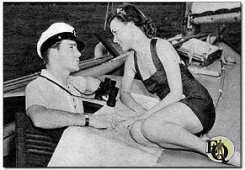 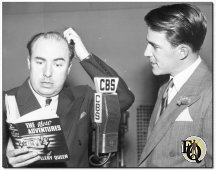 Above left: This might be some polished scene from an adventure of radio's gentlemen detective, Ellery Queen, for both Ellery and Nikki seemed to be in character as this photograph was taken. But it isn't. Good pals in life, as well as on the air, they were photographed while enjoying an outing on Mark Warnow's yacht. - ED (Picture by Walter Seigal) (from Radio Guide, Jan 5. 1940). Above right: Arthur Mann, was Ted Cott's victim on the popular Sunday afternoon music quiz, So You Think You Know Music. Then he umpired his own sports quiz, and wound up the day matching wits with Ellery Queen. No wonder Arthur looks bewildered... (from a Radio Studio Picture, May 1940) |
|
|
Throughout his career Hugh kept performing on Broadway. In late 1940 early 1941,
he was romantically linked to actress Cynthia Carlin. In 1941 he performed
in the Broadway play The Land is Bright (Music Box
Theatre, Oct 28. 1941 - Jan 3. 1942) as Wayne Kincaid. In this
play he met K.T. Stevens, daughter of director Sam Wood. But he married Edith
Atwater in Chicago on November 15. 1941. The news came as a surprise even to their friends, for the the young
actress and actor only decided to get married a day or two before. A quiet
ceremony with no wedding trip, for the bridegroom had performances of The Land is Bright planned the same day. The couple appeared
together in a Barnard Bond show at McMillin Theater on April 23. 1942 in a
sketch entitled "A Very Nice Dinner". He divorced Edith in September 1945. Together with K.T. Stevens he went on tour with the Chicago production of The Voice of the Turtle (1944 - 1946), they fell for each other and married in 1946 in San Francisco. The couple went on to grace more than 20 stage shows together, including, after Hugh's Broadway flop It Take Two (Biltmore Theatre, Feb 3. - 8. 1947), Laura (Cort Theatre, Jun 26. - Aug 2. 1947) on the classic film with the same name from 1944. Duet for Two Hands (Booth Theatre, Oct 7. - 11. 1947) was another short-lived Broadway play for Hugh. |
|
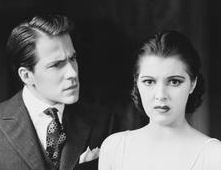
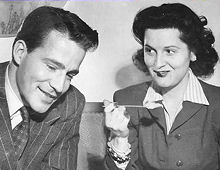 Above left: Broadway play The Land is Bright (Music Box Theatre, Oct 28. 1941 - Jan 3. 1942) as Wayne Kincaid opposite Diane Barrymore (related to Drew Barrymore!). Above right: Mr. and Mrs. Hugh Marlowe (Edith Atwater), who are having a reunion with their Chicago friends while he is here to play opposite Gertrude Lawrence in Lady in the Dark at the Civic Opera House. (Jan, 1943). Afterwards the play went on to Broadway (Broadway Theatre, Feb 27. - May 15. 1943). |
|
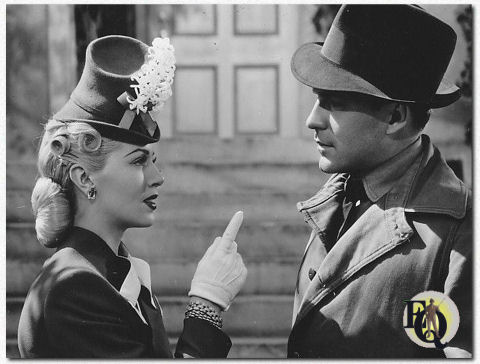 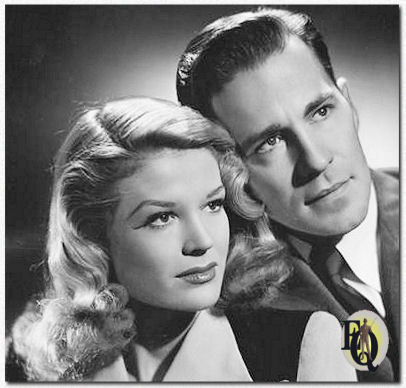 Above left: Going my way?... But it's more a command than a question, When Lana Turner puts it to Hugh Marlowe in a scene in Metro-Goldwyn Mayer's Marriage Is A Private Affair (MGM, Aug 23. 1944). As her husband and a habitual drinker, Marlowe has been missing for days and in a round-about way throwing more strain on Lana's marriage in the story to John Hodiak. Robert Z. Leonard directed the drama of a wartime bride and her emotional problems. Above right: K.T. Stevens and Hugh Marlowe, who were offstage principals in a marriage ceremony this week, continue to delight audiences with their make believe romance and bright comedy in The Voice of the Turtle (1944 - 1946), originally a 1943 - 1948 Broadway hit. |
|
| Marlowe appeared in such notable movies as Meet Me in St. Louis (MGM, Nov 22. 1944), Twelve O'Clock High (20th Century Fox, Dec 21. 1949), All About Eve (20th Century Fox, Oct 13. 1950) (below top), Night and the City (20th Century Fox, Jun 9. 1950) and The Day the Earth Stood Still (20th Century Fox, Sep 18. 1951) with Patricia O'Neal (below bottom right). | |
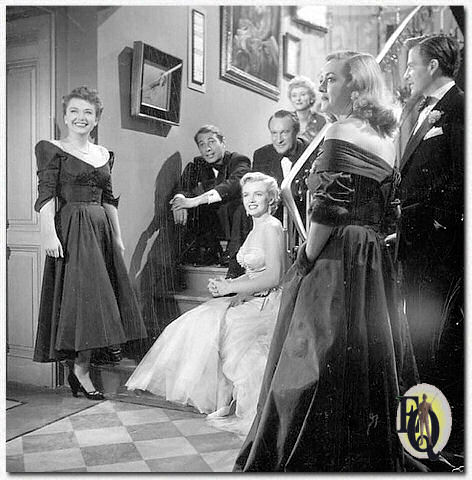 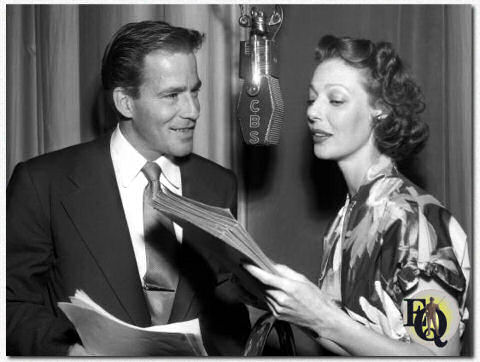 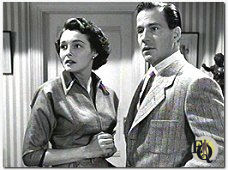 Top: The phenomenal cast of All about Eve (20th Century Fox, Oct 13. 1950) during a pause in filming. (L to R) Anne Baxter, Gary Merrill, Marilyn Monroe, George Sanders, Celeste Holm, Bette Davis and Hugh Marlowe. Above left: Episode of radio's Lux Radio Theatre (Apr 3. 1950) reenacting Come to the Stable, which had been released in cinemas the previous year. Hugh Marlowe and Loretta Young reprised their roles. Above right: With Patricia O'Neal in The Day the Earth Stood Still (20th Century Fox, Sep 18. 1951). |
|
|
Making his first TV Guest Appearance in
The
Philco Television Playhouse
episode: "Train to Trouble" (NBC, Nov 8. 1953). Soon thereafter he got the title role
in The
Adventures of Ellery Queen
(TPA, 1954 - 56) a role he already played
some 14 years earlier in radio. In 1954 Hugh Marlowe had this to say on TV sleuths: "In spite of what everybody says, a mystery plot is one of the few that can be solved in 28 minutes. You don't need Robert E. Sherwood to write it. I would rather do a 28-minute mystery well than some great classic that would require 50 hours of rehearsal and would fail because It couldn't be crowded into an hour." |
|
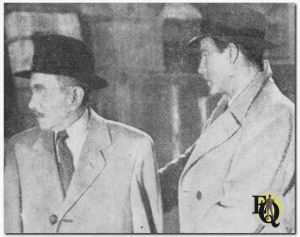 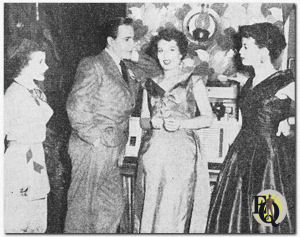 Above left: Florenz Ames (left) as Inspector Queen, and Hugh Marlowe as Ellery Queen in a tense moment from one of the thrilling episodes of The Adventures of Ellery Queen aka Mystery is My Business. This episode is entitled "Mardi Gras" (Oct 09 1955). Above right: A televised scene from The Adventures of Ellery Queen. In the centre is Hugh Marlowe who plays the title role. He's looking at actress Jean Willes. |
|
| The episodes were shot at the Motion Picture Center early in 1954. When interviewed on Ellery Queen Hugh had this to say: "Queen is a changed man now. Then he relied strictly on his wits to solve crimes. There wasn't much physical work involved. But television has toughened him up. Now I get to trade punches with a few of the hardened criminals with which I come in contact." | |
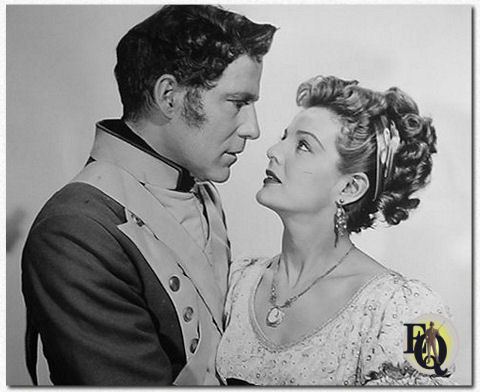 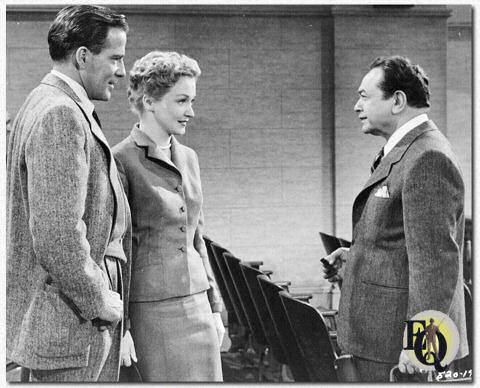 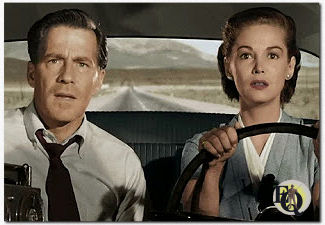  Top left: Hugh Marlowe and Marjorie Lord in "Her Kind of Honor", a story of love and intrigue in the days of Napoleon on TV's Schlitz Playhouse of Stars (Mar 19. 1954). Top right: Hugh Marlowe, Nina Foch, Edward G. Robinson in Illegal (1955) where Marlowe plays a young, ambitious lawyer. Above left: Dr. Russell Marvin (Hugh Marlowe) and his wife Carol Marvin (Joan Taylor) both scientists experimenting with rockets to probe the upper atmosphere for future space flight in Earth vs Flying Saucers (1956). Above right: Hugh Marlowe and Eva Bartok in an episode from The Joseph Cotton Show - On Trial! called "The Case of the Abandoned Horse" (NBC-television, Apr 12.1957) |
|
|
The TV series Alfred Hitchcock Presents (CBS, Dec 30. 1956 - Dec 12. 1961, min. 5x) has had several roles for Hugh Marlowe playing Harold Skinner, Rev. Richard Fell, Dr. Ralph Mannick, Philip Baxter Sr., and Bernard Butler. On April 8. 1956 Hugh and K.T.'s Brentwood home suffered an estimated $25,000 damage after fire broke out in a closet. It spread to several other rooms before firemen controlled it. The actor was appearing in a stage play. Luckily his wife and children and a housekeeper fled unharmed. |
|
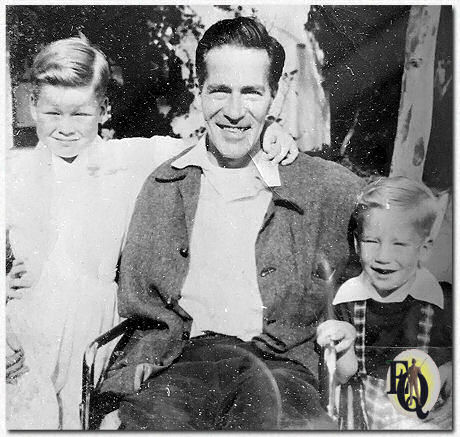 Above: Hugh on a trip with the family to San Juan Capistrano in the photo with son Jeff (left) and Chris (right). |
|
|
Racier than any of his on-screen roles was an incident that
took place around the same time as the fire when Marlowe was starring in Anniversary Waltz at the Alcazar Theatre in San Francisco in April 1956. A
few seconds after the curtain went down on the second act, his co-star Marjorie
Lord slapped his face and sent him reeling. And Marlowe slapped her back. The
tabloids loved it. HE KISSES, SHE SLAPS, HE'S FIRED,
headlined the New York Journal-American.
Versions of the incident differed. The feud had started a week or so earlier
when Marjorie Lord objected that Marlowe was "overly ardent in the love
scenes." She accused him of inventing 'some quite violent embraces that
weren't in the script at all." That night something happened to provoke the
fight. In newspapers Marjorie was quoted "Frequently he...well, some things
just weren't in the script," and "Mr. Marlowe didn't seem to be
impressed with dialogue so I slapped him." The role of a doctor is a popular role for Hugh Marlowe. In Earth vs. Flying Saucers (Columbia, July 1. 1956) he played Dr. Russell A. Marvin, in World Without End (Allied Artists, Mar 25. 1956) he was Dr. John Borden and Doc Carozal in Castle of Evil (World Entertainement, Nov 1966). |
|
 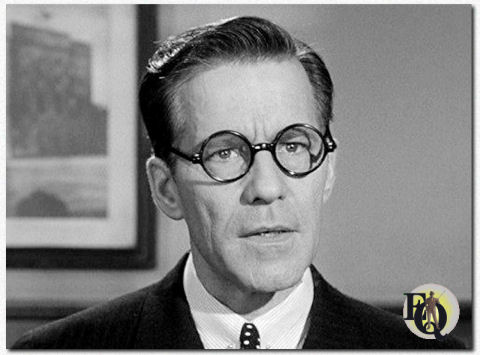 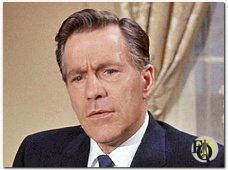 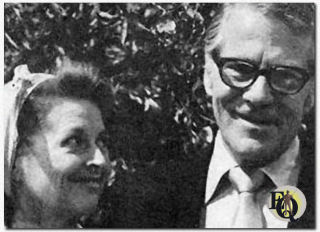 Top left: Dody Heath and Hugh Marlowe CBS promo photo for the Alfred Hitchcock Presents episode "Touché " aired Jun 14. 1959. Top right: In Birdman of Alcatraz (United Artists, Jul 4. 1962) as Roy Comstock Above left: Hugh Marlowe in 13 Frightened Girls (Columbia, July 1963) Above right: From 1964 to 1982 he was the last of four actors to portray the Matthews family patriarch Jim Matthews in the daytime serial Another World (NBC, Nov 11. 1964 - Apr 13. 1982, min. 1907x) . Seen here with Virginia Dwyer (1964). |
|
|
From then on he appeared primarily as a television guest star, usually in westerns or crime dramas. In 1962, Marlowe played the part of Sam Garner in the episode "The Pitchwagon" on CBS's Rawhide. He made guest appearances on Perry Mason, (CBS, Feb 7. 1959 - Oct 24. 1965, min. 6x). The marriage with KT Stevens
went well until about 1966, when Hugh fell in love
with his co-star, the talented young actress Rosemary Torri. They started an
affair, and in mid 1968, Rosemary got pregnant. K.T. and Hugh divorced in a
quick fashion and Hugh married Rosemary right after the divorce was made final.
Their son, Hugh Marlowe III, was born in February 1969.
4 |
|
 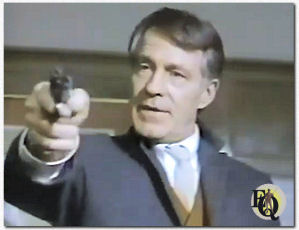 Above left: In the episode from TV's Voyage to the Bottom of the Sea , "Thing from Inner Space" (ABC, Nov 6. 1966) Marlowe played Bainbridge Wells. Above right: In The Last Shot You Hear (20th Century Fox, May 14. 1969) Hugh played Charles Nordeck internationally famed marriage-counselor who demonstrates the use of his gun on his wife. |
|
|
In The Last Shot You Hear (20th Century Fox, May 14. 1969) Hugh played Charles Nordeck internationally famed marriage-counselor who demonstrates the use of his gun on his wife. (above left). From 1964 to 1982 he was the last of four actors to portray the Matthews family patriarch Jim Matthews in the daytime serial Another World (NBC, Nov 11. 1964 - Apr 13. 1982, min. 1907 x) (see below). On May 2. 1982 Hugh Marlowe passed away in his Manhattan apartment New York, New York from a heart attack. |
|
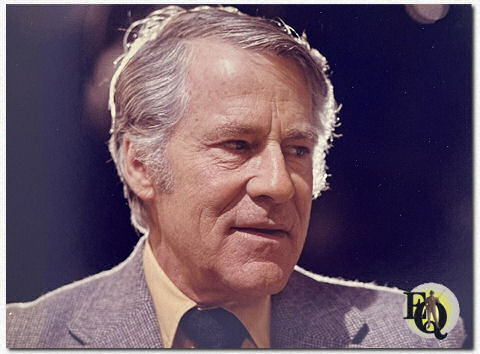 |
|
|
Notes: All dates for movies are for the first US release. All dates for TV programs are original first airdates. All dates for (radio) plays are for the time span the actor was involved. Facts in red still need confirmation. |
|
|
Click on Uncle Sam if you think you can help out...!
|
|
|
Other references
Additional video & audio sources |
|
|
This actor profile is a part of
Ellery Queen a website on deduction.
The actor above played Ellery Queen in
an Ellery Queen radio and
TV-series. Click Uncle Sam if you think you can
help out...! Many of the profiles on this site have been compiled after very careful research of various sources. Please quote and cite ethically! |
|
|
Page first published before June 18. 2016 Version x2.1 - Last updated April 22. 2025 |
|
 b a c k
t o L i s t o f S u s p
e c t s
b a c k
t o L i s t o f S u s p
e c t s
|
|
Introduction | Floor Plan | Q.B.I. |
List of Suspects | Whodunit? | Q.E.D. | Kill as directed | New | Copyright  Copyright © MCMXCIX-MMXXV Ellery Queen, a website on deduction. All rights reserved. |